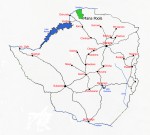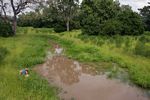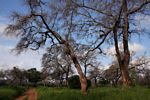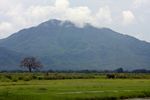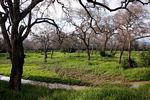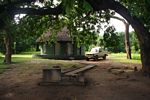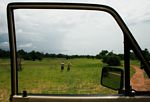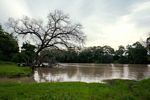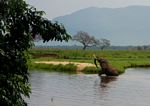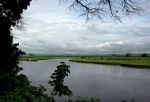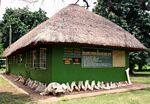Location: Mana Pools National Park (including the Sapi and Chewore Safari Areas)
Photo: Bart Wursten
One of Mana's many pools during the rainy season with Petra looking for Marsilea minuta, one of its very few fern species
Photo: Bart Wursten
Faidherbia albida shed their leaves in summer when everything else is lush and green
General Information
Quarter degree square: Many QDS lying between 15° 37' to 16° 25' S & 29° 08' to 30° 20' E Country: Zimbabwe Habitat: Sandy islands, riverine forest, floodplains with alluvial soils, Mopane woodland, deciduous woodland on rocky escarpments and extensive areas of 'Jesse-bush'. Altitude range: Mostly between 350 and 400m; up to 1,244m on the slopes of the Zambezi escarpment Annual rainfall: c. 700mm, falling mainly in summer. The mean annual temperature is 25°C. Location (short): Location (detailed): The three together cover a total area of nearly 10,000 km² in Urungwe district, Mashonaland West, all managed by the Zimbabwean Department of National Parks and Wildlife Management, except for relatively small areas around the towns of Kariba and Chirundu permanently settled by human populations. |
Description
Mana Pools National Park, together with the Chewore, Sapi and Urungwe Safari Areas, forms an almost continuous band of protected and nearly pristine natural wilderness along the Zambezi River from Lake Kariba to the border with Mozambique at Kanyemba.
Much of the area has been protected from hunting since 1963 and, while the three safari areas are now used as controlled and limited commercial hunting concessions, Mana Pools has been fully protected as a National Park since 1975.
Mana Pools National Park, Sapi Safari Area and Chewore Safari Area were inscribed as World Heritage sites in 1984.
Most of the area is located in the wide floodplain of the Zambezi River flanked in the South by the rugged hills of the Zambezi escarpment which rise up from the valley floor to an altitude of over 1000m. Much of the habitats on the escarpment itself are also protected. The pools which have given the National Park its name are formed by remains of ancient channels of the Zambezi.
The soils are mainly sandy except for the alluvial soils deposited by the river in areas that are subject to regular flooding and the rocky areas on the escarpment.
The main vegetation types consist of mixed miombo and Brachystegia woodlands on the escarpment and higher areas of Chewore. The valley floor is dominated by vast expanses of mopane (Colophospermum mopane) woodlands or dry deciduous thickets known as 'jesse bush'. More dense riparian vegetation can be found along the banks of the pools and the, often seasonal, tributaries, which cross the valley on their way to the Zambezi. The more open woody vegetation on the alluvial soils of the floodplains is dominated by open forests of large Faidherbia albida and small patches of more diverse woodland on slightly higher ground of old islands or termite mounds, featuring Kigelia africana, Trichilia emetica or majestic specimens of Ficus bussei.
Bird life is prolific, particularly near the river, with nearly 400 species recorded.
However, the main attraction for visitors undoubtedly lies in the rich and varied populations of wildlife, particularly during the dry season when the animals are relying on the river and the major pools for water and the fruiting Faidherbia albida provide a rich source of food. Most well-known mammals of the African bush are present and thriving in this environment, except giraffe which has always been conspicuously absent from this part of Africa, and rhinoceros. Until the mid-eighties of the last century, the area boasted one of the largest populations of Black Rhino in Africa with about 500 individuals but these were almost poached to extinction and the last remaining animals were captured in 1994 and translocated to other parts of Zimbabwe which offered better protection.
Useful links
View a list of records for Mana Pools National Park (including the Sapi and Chewore Safari Areas)
